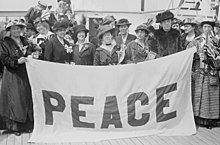
World War I marked the first war in which American women were allowed to enlist in the armed forces. While thousands of women did join branches of the army in an official capacity, receiving veterans status and benefits after the war's close, the majority of female involvement was done through voluntary organizations of the war effort or through becoming a nurse for the military.[1][2] Additionally, women made an impact on the war indirectly by filling the workforce, becoming employed in the jobs left behind by male soldiers.
During the course of the war, 21,498 U.S. Army nurses (American military nurses were all women then) served in military hospitals in the United States and overseas. Many of these women were positioned near to battlefields, and they tended to over a million soldiers who had been wounded or were unwell.[8] 272 U.S. Army nurses died of disease (mainly tuberculosis, influenza, and pneumonia).[9] Eighteen African-American Army nurses served stateside caring for German prisoners of war (POWs) and African-American soldiers. They were assigned to Camp Grant, IL, and Camp Sherman, OH, and lived in segregated quarters.[3][10][11]

Hello Girls was the colloquial name for American female switchboard operators in World War I, formally known as the Signal Corps Female Telephone Operators Unit. During World War I, these switchboard operators were sworn into the Army Signal Corps.[12] This corps was formed in 1917 from a call by General John J. Pershing to improve the worsening state of communications on the Western front. Applicants for the Signal Corps Female Telephone Operators Unit had to be bilingual in English and French to ensure that orders would be heard by anyone. Over 7,000 women applied, but only 450 women were accepted. Many of these women were former switchboard operators or employees at telecommunications companies.[12] Despite the fact that they wore Army Uniforms and were subject to Army Regulations (and Chief Operator Grace Banker received the Distinguished Service Medal),[13] they were not given honorable discharges but were considered "civilians" employed by the military, because Army Regulations specified the male gender. Not until 1978, the 60th anniversary of the end of World War I, did Congress approve veteran status and honorable discharges for the surviving women who had served in the Signal Corps Female Telephone Operators Unit.[14]
During WWI, large numbers of women were recruited into jobs that had either been vacated by men who had gone to fight in the war, or had been created as part of the war effort. The high demand for weapons and the overall wartime situation resulted in munitions factories collectively becoming the largest employer of American women by 1918. While there was initial resistance to hiring women for jobs traditionally held by men, the war made the need for labor so urgent that women were hired in large numbers and the government even actively promoted the employment of women in war-related industries through recruitment drives. As a result, women not only began working in heavy industry, but also took other jobs traditionally reserved solely for men, such as railway guards, ticket collectors, bus and tram conductors, postal workers, police officers, firefighters, and clerks.[15]
World War I saw women taking traditionally men's jobs in large numbers for the first time in American history. Many women worked on the assembly lines of factories, producing trucks and munitions, while department stores employed African American women as elevator operators and cafeteria waitresses for the first time. The Food Administration helped housewives prepare more nutritious meals with less waste and with optimum use of the foods available. Most important, the morale of the women remained high, as millions joined the Red Cross as volunteers to help soldiers and their families, and with rare exceptions, the women did not protest the draft.[16][15]
The Department of Labor created a Women in Industry group, headed by prominent labor researcher and social scientist Mary van Kleeck.[17] This group helped develop standards for women who were working in industries connected to the war alongside the War Labor Policies Board, of which van Kleeck was also a member. After the war, the Women in Industry Service group developed into the U.S. Women's Bureau, headed by Mary Anderson.[18][19]
Social status often dictated the way in which a woman was involved in the war effort. Working-class women were generally the ones enlisting in the armed forces or taking over jobs left behind, while middle and upper-class women generally participated in voluntary organizations.[20] These were the women with more free time, whose living standards did not necessitate that they earn a salary. One prominent issue at the outset of the war was how to organize and coordinate female support and service, which led for female leaders to push for the creation of the Woman's Committee of the Council of National Defense (WCND), established by the Wilson administration to serve as an advisory committee.[21] The Committee appropriated projects to voluntary organizations such as the Red Cross, Women's Temperance Union and others, in order to drum up support for the war and mobilize the female half of the population amidst rising manpower concerns.

While women were lauded for their patriotism and support in the Great War, many were also involved in protesting the war and encouraging an internationally agreed upon framework for a return to peace. Alice Paul, the famed advocate for women's suffrage, led the National Women's Party in multiple protests at the White House. One argument commonly made was that the United States should not have been intervening abroad, when they were still not providing equal rights and assurances to its own citizens, including still not allowing women to vote. The Woman's Peace Party, led by President Jane Addams, was another strong voice that came out in opposition to the war. By 1915, the organization had over 40,000 members. Jane Addams met with President Woodrow Wilson six times to discuss the war.[22]

